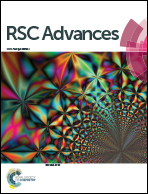Enrichment of nitrifying bacteria and microbial diversity analysis by high-throughput sequencing†
Abstract
To achieve nitrifying bacteria (ammonia-oxidizing bacteria (AOB) and nitrite-oxidizing bacteria (NOB)) growth, activated sludge from the A2/O process in a wastewater treatment plant (WWTP) was used as seed sludge to guide the industrial culture of nitrifying bacteria for ammonia-contaminated wastewater treatment. The bacterial community was enriched in a fully automatic miniature fermenter by an alternating mode of intermittent operation mode in the daytime and a continuous ammonia feeding mode for intermittent operation during the night. The results indicated that the nitrifying bacteria community can be enriched by this alternating operation mode, resulting in a maximum ammonia oxidation rate reaching approximately 110 mg L−1 h−1 and a nitrite oxidation rate of approximately 50 mg L−1 h−1. High-throughput sequencing demonstrated that Nitrosomonas and Nitrospira belonging to AOB and NOB, respectively, were predominant in the activated sludge after 25 days at a ratio extending from 2.94% to 60.66%.



 Please wait while we load your content...
Please wait while we load your content...